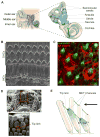Usher syndrome: Hearing loss, retinal degeneration and associated abnormalities
- PMID: 25481835
- PMCID: PMC4312720
- DOI: 10.1016/j.bbadis.2014.11.020
Usher syndrome: Hearing loss, retinal degeneration and associated abnormalities
Abstract
Usher syndrome (USH), clinically and genetically heterogeneous, is the leading genetic cause of combined hearing and vision loss. USH is classified into three types, based on the hearing and vestibular symptoms observed in patients. Sixteen loci have been reported to be involved in the occurrence of USH and atypical USH. Among them, twelve have been identified as causative genes and one as a modifier gene. Studies on the proteins encoded by these USH genes suggest that USH proteins interact among one another and function in multiprotein complexes in vivo. Although their exact functions remain enigmatic in the retina, USH proteins are required for the development, maintenance and function of hair bundles, which are the primary mechanosensitive structure of inner ear hair cells. Despite the unavailability of a cure, progress has been made to develop effective treatments for this disease. In this review, we focus on the most recent discoveries in the field with an emphasis on USH genes, protein complexes and functions in various tissues as well as progress toward therapeutic development for USH.
Keywords: Hair bundle link; Inner ear hair cell; Periciliary membrane complex; Retina photoreceptor; Therapy; USH multiprotein complex.
Copyright © 2014 Elsevier B.V. All rights reserved.
Figures




References
-
- LeMasurier M, Gillespie PG. Hair-cell mechanotransduction and cochlear amplification. Neuron. 2005;48:403–415. - PubMed
-
- Eatock RA, Songer JE. Vestibular hair cells and afferents: two channels for head motion signals. Annu Rev Neurosci. 2011;34:501–534. - PubMed
-
- Khan S, Chang R. Anatomy of the vestibular system: a review. NeuroRehabilitation. 2013;32:437–443. - PubMed
Publication types
MeSH terms
Substances
Grants and funding
LinkOut - more resources
Full Text Sources
Other Literature Sources
Medical

